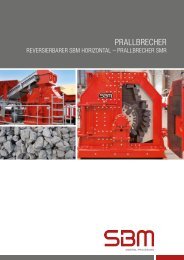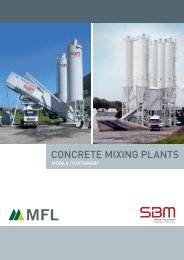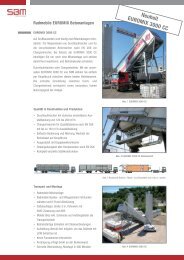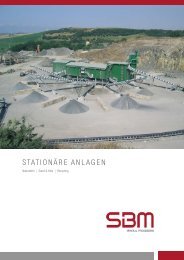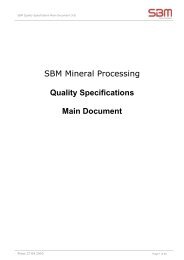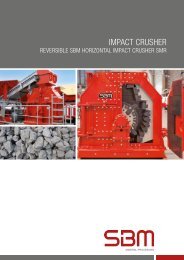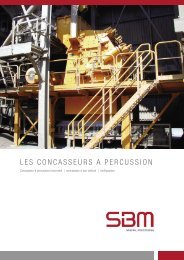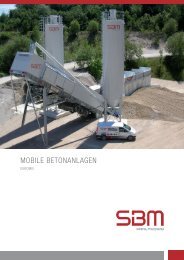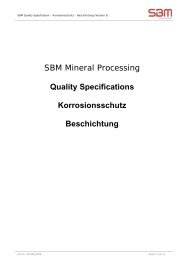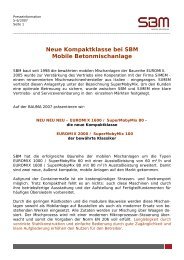Product line impact crushers - SBM
Product line impact crushers - SBM
Product line impact crushers - SBM
You also want an ePaper? Increase the reach of your titles
YUMPU automatically turns print PDFs into web optimized ePapers that Google loves.
Impact Crushers<br />
Horizontal Impact Crushers | Vertical Impact Crushers | Multipactor
<strong>SBM</strong> <strong>impact</strong> <strong>crushers</strong><br />
yesterday – today – tomorrow<br />
<strong>SBM</strong>'s history started more than 50<br />
years ago with the development of the<br />
legendary swing beam mill, which also<br />
gave <strong>SBM</strong> its name. Today about 5000<br />
<strong>impact</strong> <strong>crushers</strong> worldwide demonstrate<br />
the efficiency, reliability and thus the<br />
success of this proven crusher concept.<br />
Experience gained with several generations<br />
of <strong>crushers</strong>, the continuous further<br />
development and optimisation of crushing<br />
chamber design and geometry<br />
have made <strong>SBM</strong> <strong>impact</strong> <strong>crushers</strong> a<br />
universal machine applicable, in many<br />
industries.<br />
The clearly defined, unique and high levels<br />
of quality, and the goal of continuous<br />
improvement of our engineering performance,<br />
products and services drive us<br />
to higher levels of achievement in the<br />
future under the banner: “Made in<br />
Austria”. Our commitment is documented<br />
in numerous certificates,<br />
including ISO9001:2000.<br />
Put your trust in the engineering and<br />
high levels of quality “Made in Austria”<br />
by <strong>SBM</strong> Mineral Processing.
<strong>SBM</strong> <strong>impact</strong> <strong>crushers</strong><br />
Versatile and economical<br />
Examples of evaluations of the <strong>SBM</strong> technical centre with its crushing and analysing systems<br />
Impact crushing – an ideal way of<br />
comminution<br />
Impact crushing offers some general<br />
advantages compared with other<br />
crushing techniques:<br />
• high degree of comminution<br />
•selective grinding<br />
•better product quality<br />
Pic. 1 Impact crushing with high degree of grinding<br />
•better grain shape / higher cubicity<br />
•better / lower <strong>impact</strong> crushing<br />
value acc. to Los Angeles<br />
•perfect loosening of concrete reinforcements<br />
in recycling processes<br />
Impact <strong>crushers</strong> –<br />
the universal <strong>crushers</strong><br />
Design benefits of <strong>impact</strong> <strong>crushers</strong> compared<br />
with cone <strong>crushers</strong>:<br />
Pic. 2 Comparison <strong>impact</strong> crusher / cone crusher: share of grain in bad shape<br />
• flexibility for varying performance<br />
requirements<br />
•insensitive against larger feed size<br />
Impact <strong>crushers</strong> –<br />
the economical machines<br />
For many applications there are economic<br />
reasons in favour of an <strong>impact</strong> crusher:<br />
• saving up to 2 crushing stages<br />
•little space required<br />
•little energy required<br />
•low investment costs<br />
•easy maintenance due to simple<br />
design<br />
•low wear costs due to innovative<br />
wear materials – even in case of<br />
abrasive materials<br />
Pic. 3 Comparison <strong>impact</strong> crusher / cone crusher: <strong>impact</strong> crushing values<br />
<strong>SBM</strong> <strong>impact</strong> <strong>crushers</strong> - a good choice<br />
With its comprehensive range of types <strong>SBM</strong> offers the right machine for every performance<br />
requirement. In terms of crusher rating we use a database and the knowhow<br />
of the <strong>SBM</strong> technical centre with its crushing and analysing systems. The competence<br />
and experience of <strong>SBM</strong> stands for the best possible combination of the relevant<br />
process parameters, a proven design, high-grade components and optimum<br />
materials. A high specific throughput, excellent production results and a long service<br />
life of the <strong>SBM</strong> <strong>crushers</strong> will win you over.
Horizontal <strong>impact</strong> <strong>crushers</strong><br />
General<br />
Both as primary or secondary crusher<br />
the <strong>SBM</strong> horizontal <strong>impact</strong> <strong>crushers</strong> are<br />
used to hard work and major challenges<br />
- primary <strong>crushers</strong> for feed size up to<br />
1,400 mm.<br />
With excellent design features and functional<br />
features they are well equipped for<br />
their future work.<br />
Pic. 2 Rotor shape SF, open<br />
Pic. 1 Horizontal <strong>impact</strong> crusher type RHS<br />
Pic. 3 Impact aprons 1 and 2<br />
Housing<br />
•heavy-duty design<br />
•lateral walls mainly made of high<br />
tensile-strength materials<br />
•modular design<br />
•largely generous equipment of rotors,<br />
aprons and armours, two intake<br />
structures to choose from<br />
(RHSMH / RHSM)<br />
•grinding path for retrofitting<br />
Crushing chambers / <strong>impact</strong> zones<br />
• zone 1:<br />
intake / rotor / first apron<br />
• zone 2:<br />
rotor / second apron<br />
high crushing material acceleration<br />
utilisation of rebound effect<br />
• zone 3:<br />
rotor / grinding path<br />
shaping area, grinding zone;<br />
length of the grinding path affects<br />
rate of oversized grain and cubicity<br />
Aprons<br />
•2 <strong>impact</strong> aprons as standard<br />
•gap adjustment hydraulic/mechanical<br />
or fully hydraulic<br />
•safety spindle for bottom stop<br />
•optimally graded gap widths affect residence<br />
time of crushing material as well<br />
as throughput<br />
Options<br />
•sensors at 2 nd <strong>impact</strong> apron for<br />
automatic reset after response of<br />
overload protection<br />
•measuring system for gap width display<br />
•automatic control via discharge curve<br />
Rotor<br />
•heavy-duty design<br />
•four rotor variants:<br />
open / closed / shape SSSL / shape SF<br />
•type, arrangement and combination of<br />
blow bars affect the crushed product<br />
as well as wear; objective: “much<br />
crushing – little grinding”<br />
•ejector for blow bars as an option<br />
•combination of penetration depth into<br />
<strong>impact</strong> circle and circumferential<br />
speed provides for good intake and<br />
maximum comminution of crushing<br />
material<br />
•rotor speed affects throughput, quality<br />
as well as grain distribution of the<br />
crushed material<br />
Drive<br />
•standard V-belt drive<br />
•flexible, for damping of shock loads<br />
•simple changing of rotor circumferential<br />
speed<br />
Due to the solid design of the rotor,<br />
the apron and the housing <strong>SBM</strong> <strong>impact</strong><br />
<strong>crushers</strong> cope with to every challenge.<br />
Pic. 4 Type 13/13/4 RHSMK 5
<strong>SBM</strong> horizontal <strong>impact</strong> <strong>crushers</strong> – primary <strong>crushers</strong><br />
Models and applications<br />
Free configuration with intakes,<br />
aprons, grinding path and rotors –<br />
adaptation to individual performance<br />
requirements due to<br />
modular design<br />
Type RHS<br />
No grinding path; selective primary<br />
crushing of medium-hard natural stone,<br />
asphalt, reinforced concrete and building<br />
rubble<br />
Technical data<br />
Type RHSM 3<br />
With 3-row grinding path for reduced<br />
share of oversized grain; selective primary<br />
crushing of medium-hard natural<br />
stone, asphalt, concrete and building<br />
rubble without reinforcement<br />
Type<br />
11/07/4 RHS<br />
11/07/4 RHSM 3<br />
11/07/4 RHSM 5<br />
11/09/4 RHS<br />
11/09/4 RHSM 3<br />
11/11/4 RHS<br />
11/11/4 RHSM 3<br />
11/11/4 RHSM 5<br />
11/13/4 RHS<br />
11/13/4 RHSM 3<br />
11/13/4 RHSM 5<br />
13/11/4 RHS<br />
13/11/4 RHSM 3<br />
13/11/4 RHSM 5<br />
13/13/4 RHS<br />
13/13/4 RHSM 3<br />
13/13/4 RHSM 5<br />
13/16/4 RHS<br />
13/16/4 RHSM 3<br />
13/16/4 RHSM 5<br />
13/19/4 RHS<br />
13/19/4 RHSM 3<br />
13/21/4 RHS<br />
13/21/4 RHSM 3<br />
14/16/6 S<br />
14/16/6 SM<br />
14/21/6 SH<br />
14/21/6 SMH<br />
16/19/6 SMH<br />
16/23/6 SMH<br />
Data<br />
Feeding<br />
size**)<br />
up to [mm]<br />
500<br />
600<br />
700<br />
900<br />
700<br />
1000<br />
700<br />
1000<br />
700<br />
1000<br />
1200<br />
1400<br />
Throughput*)<br />
from – to<br />
[tons/h]<br />
80 - 140<br />
90 - 160<br />
100 - 180<br />
150 - 220<br />
110 - 220<br />
180 - 300<br />
220 - 360<br />
260 - 410<br />
220 - 360<br />
270 - 420<br />
350 - 540<br />
650 - 800<br />
800 - 1000<br />
Intake<br />
opening<br />
H x W [mm]<br />
725 x 645<br />
725 x 835<br />
725 x 1030<br />
850 x 1260<br />
1030 x 1030<br />
830 x 1030<br />
1030 x 1260<br />
830 x 1260<br />
1030 x 1540<br />
830 x 1540<br />
1030 x1860<br />
1030 x 2020<br />
1400 x 1510<br />
1400 x 2030<br />
1650 x 1845<br />
1650 x 2300<br />
Number<br />
of blow<br />
bars<br />
3/4<br />
3/4/6<br />
4/6<br />
3/4/6<br />
4/6<br />
3/4/6<br />
4/6<br />
Weight<br />
approx.<br />
[kg]<br />
7150<br />
7600<br />
9500<br />
9500<br />
10800<br />
11600<br />
12300<br />
12900<br />
13500<br />
14200<br />
15800<br />
15300<br />
16800<br />
18200<br />
17500<br />
18300<br />
19800<br />
20000<br />
21500<br />
23800<br />
26350<br />
28250<br />
28600<br />
31000<br />
31500<br />
33500<br />
44500<br />
46500<br />
69000<br />
78000<br />
Driving<br />
power*)<br />
up to [kW]<br />
110<br />
132<br />
160<br />
200<br />
160<br />
160<br />
250<br />
250<br />
315<br />
315<br />
355<br />
400<br />
355<br />
450<br />
630<br />
850<br />
Rotor<br />
[mm]<br />
1060<br />
1280<br />
1310<br />
1600<br />
*) depends on feed material and machine setting<br />
**) data refer to body diagonal<br />
Type RHSM 5<br />
With 5-row grinding path for reduced<br />
share of oversized grain and best cubicity;<br />
selective primary crushing of mediumhard<br />
natural stone, asphalt, concrete and<br />
building rubble without reinforcement<br />
Type SM<br />
5-6-row grinding path for maximum<br />
degree of crushing; selective primary<br />
crushing of medium-hard natural stone<br />
with large feeding sizes<br />
Type S – without grinding path
<strong>SBM</strong> horizontal <strong>impact</strong> <strong>crushers</strong> – secondary <strong>crushers</strong><br />
Models and applications<br />
Free configuration with intakes,<br />
aprons, grinding path and rotors<br />
– adaptation to individual performance<br />
requirements due to<br />
modular design<br />
Type S<br />
No grinding path; selective secondary<br />
crushing of medium-hard to tough-hard<br />
natural stone; mechanical apron adjustment;<br />
perfectly suitable for minor feeding<br />
capacities<br />
Type SM<br />
With grinding path for reduced share of<br />
oversized grain; selective secondary<br />
crushing of medium-hard to tough-hard<br />
natural stone; mechanical apron adjustment;<br />
perfectly suitable for minor feeding<br />
capacities<br />
Technical data<br />
Type<br />
Data<br />
Feeding<br />
size**)<br />
up to [mm]<br />
Throughput*)<br />
from – to<br />
[tons/h]<br />
Intake<br />
opening<br />
H x W [mm]<br />
Number<br />
of blow<br />
bars<br />
Weight<br />
approx.<br />
[kg]<br />
Driving<br />
power*)<br />
up to [kW]<br />
Rotor<br />
[mm]<br />
Type RHSMK 3<br />
With 3-row grinding path; selective secondary<br />
crushing of medium-hard to<br />
tough-hard natural stone, asphalt, concrete<br />
and/or building rubble without reinforcement;<br />
hydraulic/mechanical apron<br />
adjustment; steep intake for very good<br />
penetration into <strong>impact</strong> circle<br />
8/5/3 S<br />
8/5/3 SM<br />
8/7/3 S<br />
8/7/3 SM<br />
11/7/4 RHSMK 3<br />
11/7/4 RHSMK 5<br />
11/9/4 RHSMK 3<br />
11/9/4 RHSMK 5<br />
11/11/4 RHSMK 3<br />
11/11/4 RHSMK 5<br />
11/13/4 RHSMK 3<br />
11/13/4 RHSMK 5<br />
13/11/4 RHSMK 3<br />
13/11/4 RHSMK 5<br />
13/13/4 RHSMK 3<br />
13/13/4 RHSMK 5<br />
13/16/4 RHSMK 3<br />
13/16/4 RHSMK 5<br />
13/19/4 RHSMK 3<br />
13/19/4 RHSMK 5<br />
13/21/4 RHSMK 3<br />
13/21/4 RHSMK 5<br />
200<br />
300<br />
300<br />
300<br />
40 - 70<br />
60 - 90<br />
80 - 140<br />
90 - 160<br />
100 - 180<br />
150 - 220<br />
110 - 200<br />
180 - 300<br />
220 - 360<br />
260 - 410<br />
350 - 460<br />
390 x 465<br />
390 x 620<br />
415 x 645<br />
415 x 835<br />
415 x 1030<br />
415 x 1260<br />
460 x 1030<br />
460 x 1260<br />
460 x 1540<br />
460 x 1860<br />
460 x 2020<br />
3/4<br />
4<br />
4<br />
3800<br />
4000<br />
4700<br />
5200<br />
7600<br />
9500<br />
9300<br />
11200<br />
11300<br />
13500<br />
13300<br />
14900<br />
13960<br />
16300<br />
18400<br />
19800<br />
20200<br />
22160<br />
26500<br />
27500<br />
31200<br />
32200<br />
75<br />
110<br />
132<br />
160<br />
200<br />
160<br />
250<br />
315<br />
355<br />
450<br />
800<br />
1060<br />
1280<br />
Type RHSMK 5<br />
Like type RHSMK 3, but with 5-row<br />
grinding path for reduced share of oversized<br />
grain and best cubicity<br />
*) depends on feed material and machine setting<br />
**) data refer to body diagonal
<strong>SBM</strong> horizontal <strong>impact</strong> <strong>crushers</strong> – secondary <strong>crushers</strong><br />
Secondary <strong>impact</strong> <strong>crushers</strong> for hard stone<br />
<strong>SBM</strong> secondary <strong>impact</strong> <strong>crushers</strong> of type<br />
HSB are the economical alternative to<br />
cone <strong>crushers</strong> for hard stone up to a<br />
feeding size of 350 mm. This is successfully<br />
demonstrated day after day by a<br />
multitude of <strong>crushers</strong> of type HSB.<br />
The main differences to the <strong>SBM</strong> <strong>impact</strong><br />
<strong>crushers</strong> of type RHS, S and SM:<br />
• special heavy-duty design of<br />
housing, rotor and aprons<br />
• special shape and arrangement of<br />
aprons<br />
• no grinding path<br />
Models and applications<br />
Pic. 1 Horizontal <strong>impact</strong> crusher type HSB-F<br />
Practical examples<br />
Crushed product curves of various materials<br />
Type HSB-F<br />
With extendable housing for excellent<br />
accessibility to wear parts; especially for<br />
new planning and sufficient space conditions<br />
Technical data<br />
Type<br />
Data<br />
Feeding<br />
size**)<br />
up to [mm]<br />
Throughput*)<br />
from – to<br />
[tons/h]<br />
Intake<br />
opening<br />
H x W [mm]<br />
Number<br />
of blow<br />
bars<br />
Weight<br />
approx.<br />
[kg]<br />
Driving<br />
power*)<br />
up to [kW]<br />
Rotor<br />
[mm]<br />
Type HSB-K<br />
With folding top for easy maintenance in<br />
confined space conditions<br />
HSB-F 100/075<br />
HSB-K 100/075<br />
HSB-F 100/112<br />
HSB-K 100/112<br />
HSB-F 100/150<br />
HSB-K 100/150<br />
HSB-F 125/112<br />
HSB-K 125/112<br />
HSB-F 125/150<br />
HSB-K 125/150<br />
HSB-F 125/187<br />
HSB-K 125/187<br />
300<br />
350<br />
75 - 100<br />
100 - 135<br />
125 - 165<br />
150 - 175<br />
175 - 215<br />
200 - 260<br />
370 x 775<br />
370 x 1150<br />
370 x 1505<br />
450 x 1150<br />
450 x 1505<br />
450 x 1880<br />
4<br />
4<br />
11000<br />
13000<br />
16500<br />
17000<br />
21500<br />
24500<br />
110<br />
132<br />
160<br />
200<br />
200<br />
250<br />
1060<br />
1250<br />
*) depends on feed material and machine setting<br />
**) data refer to body diagonal
<strong>SBM</strong> reversible horizontal <strong>impact</strong> <strong>crushers</strong><br />
The reversible <strong>SBM</strong> <strong>impact</strong> <strong>crushers</strong> of<br />
type SMR are universal <strong>crushers</strong> for mineral<br />
raw materials. Depending on the<br />
operating method a very high share of<br />
sand or grit can be produced.<br />
The benefits of the SMR <strong>impact</strong> crusher<br />
in terms of process engineering and<br />
economic efficiency are as follows:<br />
• high share of medium-sized grain<br />
in the range of sand or grit<br />
possible<br />
• low share of filler<br />
• regular crushed product due to<br />
re-sharpening of blow bars owing<br />
to the reverse operation<br />
• low wear costs due to maximum<br />
degree of efficiency of wear parts<br />
Wear data in actual duty<br />
Feed material<br />
Quartzporphyry<br />
River gravel 97 %<br />
Limestone<br />
LD slag<br />
Feeding size [mm]*<br />
16/45 + 8/30<br />
SiO 2<br />
16/32 (50) in circuit 4/120<br />
32/150<br />
Throughput [tons/h]*<br />
100<br />
100<br />
80<br />
80 - 100<br />
v [m/s]*<br />
44<br />
32<br />
45<br />
53<br />
Service life (approx. h)/<br />
set of blow bars*<br />
400<br />
60<br />
1550<br />
90<br />
Pic. 1 Impact crusher type SMR<br />
*) depends on feed material and machine setting<br />
Effect of crushing gap<br />
Systematic control of crushed<br />
product via<br />
• adjustment of crushing gap and speed<br />
• design of rotor and aprons<br />
• geometry of crushing chamber<br />
Compact design for installation<br />
• in confined space conditions<br />
• in mobile or semi-mobile plants<br />
Effect of rotor circumferential speed<br />
Serviceability due to<br />
• split and bolted housing to ensure<br />
good accessibility<br />
• 4 ultra-large maintenance doors<br />
• pushed in wear parts
<strong>SBM</strong> reversible horizontal <strong>impact</strong> <strong>crushers</strong><br />
Design features and variants of SMR<br />
<strong>impact</strong> <strong>crushers</strong>:<br />
2 rotor versions<br />
• rotor with straight blow bars as<br />
standard with reinforced web for<br />
feeding a coarse lumps with a share of<br />
100-150 mm<br />
• rotor and aprons with X-blow bars<br />
increase the share of 0.5-5 mm and<br />
lower the share of filler<br />
Crushing gap adjustment<br />
• mechanical via spindle<br />
•automatic by means of hydraulic<br />
system and gap display (opt.)<br />
Pic. 1 Crushing chamber of an SMR with wear parts<br />
Closed rotor with 4 straight blow bars<br />
Technical data<br />
Machine type<br />
Feeding size<br />
up to [mm]<br />
For rotor circumferential<br />
speed [m/s]<br />
Through-put<br />
[tons/h]<br />
Driving power<br />
[kW]<br />
Examples of achieved end product<br />
over K80 at delivered particle size<br />
Machine<br />
weight [kg]<br />
10/05/2 SMR<br />
10/05/2 SMR-X<br />
10/05/4 SMR<br />
10/05/4 SMR-X<br />
80<br />
150<br />
50 - 75<br />
30 - 60<br />
80<br />
130<br />
75 - 160<br />
75 - 160<br />
v=71m/s; river gravel; K80:0/2.8 mm<br />
for feed 8/16 mm<br />
v=44m/s; river gravel; K80:0/14 mm<br />
for feed 32/80 mm<br />
7900<br />
8900<br />
8100<br />
9100<br />
10/10/2 SMR<br />
10/10/4 SMR<br />
80<br />
150<br />
50 - 75<br />
30 - 60<br />
150<br />
200<br />
110 - 250<br />
110 - 250<br />
v=50m/s; river gravel; K80:0/5.6 mm<br />
for feed 8/16 mm<br />
v=37m/s; river gravel; K80:0/11 mm<br />
for feed 32/150 mm<br />
12000<br />
12400<br />
Type SMR with 4 blow bars Type SMR with 2 blow bars Type SMR X<br />
Secondary and tertiary crushing; selective<br />
crushing of soft to medium-hard<br />
natural stone and slag up to a feeding<br />
size of 150 mm; ideal for shaping and<br />
optimising the L.A. value<br />
Tertiary crushing; selective crushing of<br />
soft to tough-hard natural stone; feeding<br />
size 2-80 mm; ideal for production of<br />
aggregates for ready-made plaster<br />
Special design for particular performance<br />
requirements (opt.)
<strong>SBM</strong> vertical<br />
<strong>impact</strong> <strong>crushers</strong><br />
dary crushing of oversized grain up to<br />
approx. 45 mm edge length.<br />
Pic. 1 + 2 <strong>SBM</strong> vertical <strong>impact</strong> crusher in operation<br />
Design and process features:<br />
Material feeding and intake control<br />
•charging via feeding hopper up to<br />
40 mm feeding size<br />
•intake control is effected via a manual<br />
orifice plate or fully automatically;<br />
feeding quantity and intake cross<br />
section are controlled via a filling level<br />
sensor.<br />
The advantages of this patent<br />
pending system<br />
•crusher can always be operated in the<br />
full load range<br />
•no air can be sucked in through the<br />
intake cross section filled with material,<br />
therefore reduced dust emmissions<br />
caused by the crusher<br />
•low wear costs per ton of crushed<br />
material, since wear is approximately<br />
equal under part load and full load<br />
Comminution in type V<br />
The whole flow of material is accelerated<br />
by the rotor and thrown against a wall of<br />
crushed material (material bed) or<br />
against anvils (higher share of fines).<br />
Pic. 3 Rotor V8 with material bed<br />
Ø rotor inside<br />
Ø rotor outside<br />
V max at tear-off edges<br />
number/height of channels<br />
feeding size<br />
with/without intake control<br />
max. motor<br />
at 50 m/s<br />
max. motor<br />
at 80 m/s<br />
throughput up to<br />
approx. weight with/<br />
without <strong>impact</strong> ring (anvils)<br />
Table of vertical <strong>impact</strong> crusher type V<br />
5500 kg/-<br />
Pic. 4 Control system and material flow<br />
<strong>SBM</strong> vertical <strong>impact</strong> <strong>crushers</strong> are <strong>crushers</strong><br />
to produce sand or reshape badly<br />
formed stone grain (cubicity). The range<br />
of application of type V includes secon-<br />
1475 min -1<br />
1000 min -1<br />
1475 min -1<br />
1000 min -1 V8<br />
800 mm<br />
-/-<br />
83 m/s<br />
3/200 mm<br />
40/-mm<br />
55 kW<br />
-/-<br />
132 kW<br />
-/-<br />
V10<br />
1000 mm<br />
-/-<br />
3/200 mm<br />
40/-mm<br />
75 kW<br />
-/-<br />
200 kW<br />
-/-<br />
V10H<br />
1000 mm<br />
-/-<br />
3/250 mm<br />
50/-mm<br />
90 kW<br />
-/-<br />
250 kW<br />
-/-<br />
86 m/s<br />
30 tons/h at 55 kW<br />
85 tons/h at 132 kW<br />
50 tons/h at 75 kW<br />
140 tons/h at200 kW<br />
50 tons/h at 90 kW<br />
180 tons/h at 250 kW<br />
7800 kg/-<br />
8000 kg/-
<strong>SBM</strong> <strong>impact</strong> crusher –<br />
Multipactor<br />
The Multipactor produces very high<br />
shares of sand or grit in a very economical<br />
way at a max. length of feeding size<br />
of 80 mm.<br />
Crushing in the Multipactor:<br />
The feed material is regularly accelerated<br />
through the three chambers. Primary<br />
crushing is effected at the <strong>impact</strong> ring or<br />
the material bed. Subsequently the precrushed<br />
material gets to the multicrushing<br />
zone, where secondary crushing<br />
is performed by <strong>impact</strong> crushing,<br />
until the desired final grain size is<br />
achieved.<br />
Pic. 1 Multipactor in operation, with vibrating feeder<br />
Comparison type V and Multipactor<br />
The degree of secondary crushing is<br />
adjustable via:<br />
•rotor speed<br />
•the number of anvils at the <strong>impact</strong><br />
ring and/or crushing at the<br />
material bed<br />
Comparison Multipactor with/without <strong>impact</strong> ring<br />
•the projection of the blow bars at<br />
the rotor<br />
Pic. 2 Rotor with 2 blow bars and <strong>impact</strong> ring<br />
Very low wear costs<br />
Because of the structural separation of<br />
material acceleration and crushing zone<br />
very hard and brittle materials can be<br />
employed to the friction zones, and<br />
tough materials can be employed to the<br />
crushing zones. Additionally, speed in<br />
the friction zone is considerably reduced<br />
at the firing edges.<br />
Ø rotor inside<br />
Ø rotor outside<br />
V max at tear-off edges<br />
number/height of channels<br />
feeding size<br />
with/without intake control<br />
max. motor<br />
at 50 m/s<br />
max. motor<br />
at 80 m/s<br />
throughput up to<br />
approx. weight with/<br />
without <strong>impact</strong> ring<br />
Table vertical <strong>impact</strong> crusher Multipactor<br />
1475 min -1<br />
1000 min -1<br />
1475 min -1<br />
1000 min -1<br />
Multipactor V18<br />
800 mm<br />
1100 mm<br />
62 m/s<br />
3/200 mm<br />
110 kW<br />
132 kW<br />
160 kW<br />
160 kW<br />
110 tons/h<br />
6900 kg/9400 kg<br />
Multipactor V20<br />
800 mm 1000 mm<br />
1100 mm 1300 mm<br />
62 m/s 65 m/s<br />
3/200 mm<br />
50 / 80 mm<br />
132 kW 110 kW<br />
250 kW 200 kW<br />
250 kW 250 kW<br />
250 kW 315 kW<br />
180 tons/h<br />
7700 kg/10200 kg<br />
Multipactor V22<br />
1000 (1200) mm<br />
1300 (1500) mm<br />
65 (68) m/s<br />
3/250 mm<br />
200 kW<br />
2 x 160 kW<br />
2 x 250 kW<br />
2 x 250 kW<br />
350 tons/h<br />
13200 kg/16200 kg
We reserve the right to make any technical alterations 0704-03PR<br />
<strong>SBM</strong> Mineral Processing GmbH<br />
Arbeiterheimstraße 46<br />
A - 4663 Laakirchen<br />
Tel: +43 (7613) 2771-0<br />
Fax: +43 (7613) 2771-359<br />
www.sbm-mp.at<br />
office@sbm-mp.at



